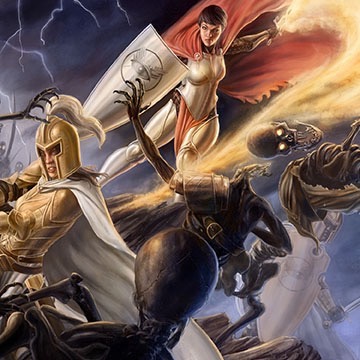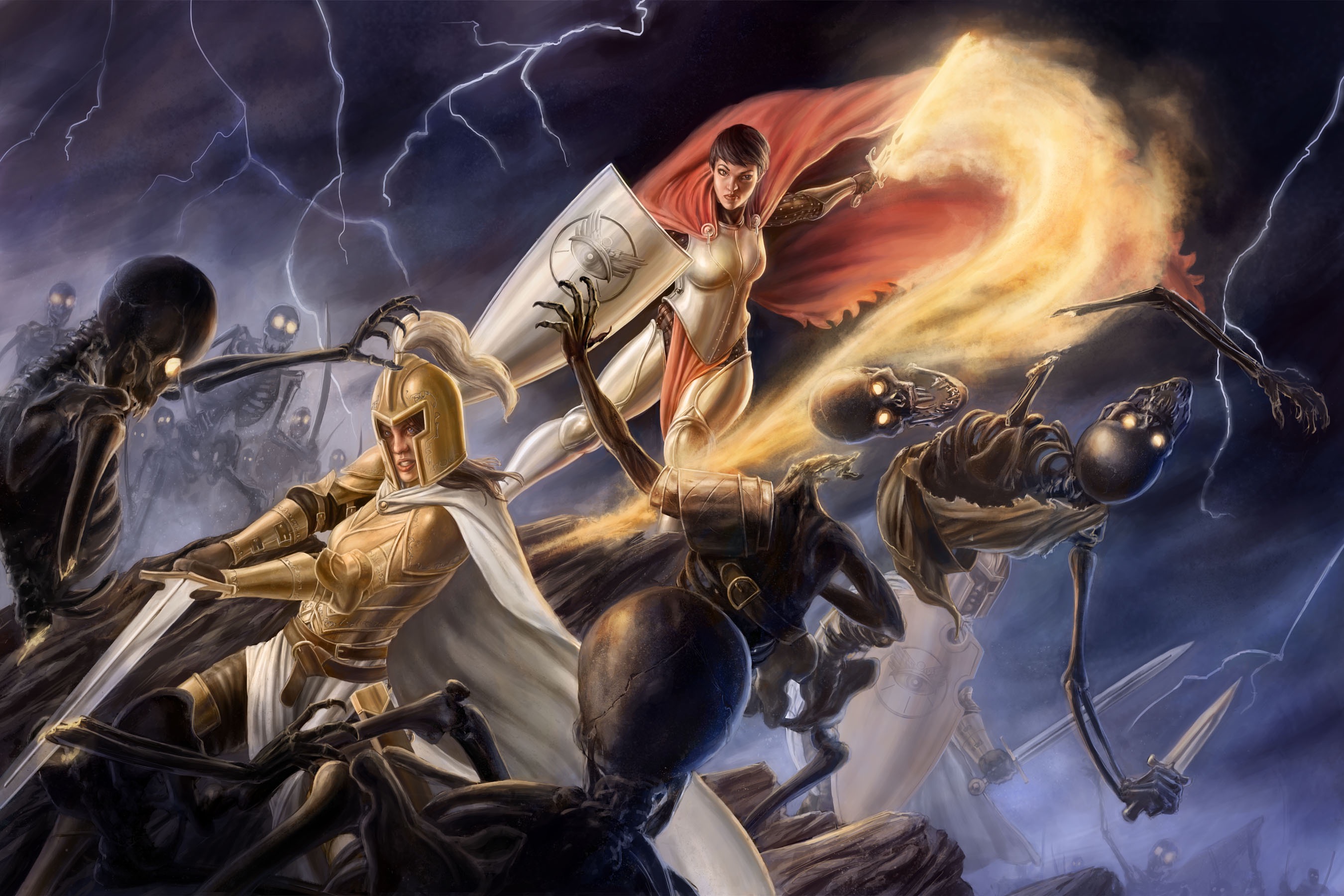We can learn much from the wisdom of the divine, but we can learn as much from their actions. The truly faithful understand that not even the gods themselves are infallible, and that words and promises do not always suffice. Those among us who see no fault in the gods are worse than zealots, worse than puppets. They taint the very idea of faith with their blind devotion. When a god makes a mistake, the results can be disastrous if their faithful do not understand the error. If they take that error as gospel, they are doomed to repeat the error and compound upon it again and again. And in so doing make the initial misstep into something more. In the worst of cases, these repeated mistakes can transcend to become the new order, and not even the gods themselves can turn them back.
Iomedae knows this well, for she was, not so long ago, among those who worshiped the gods herself.
Before her Ascension, Iomedae worshiped Arazni, the herald of the god of humanity, Aroden. When Arazni was defeated during the Shining Crusade, Iomedae turned her faith to Aroden. That Iomedae herself chose the path of a paladin was an indication of the strength of her convictions, for Arazni did not particularly embody the strictures of law, nor did Aroden particularly promote acts of goodness. But Iomedae saw the devotion to tradition and honor in Arazni’s deeds and could sense the underlying kindness and generosity in Aroden’s acts even if he didn’t notice them himself.
Even after she ascended to divinity herself, she continued to serve as Aroden’s new herald, and when the god of humanity perished unexpectedly at the dawning of the Age of Lost Omens, Iomedae did not lose hope. In the decades to follow, Iomedae’s faith grew and she inherited Aroden’s mantle. And as her church grew, she spread her wisdom to those who would listen. She told her followers to avoid her faults. To watch and judge themselves when she would misstep, and to not take her errors as gospel. For even before Iomedae’s apotheosis, she had noted imperfections in the gods she venerated, and as a goddess herself she vowed to never encourage the same unwavering zeal. And as such, she commanded that those who would worship her learn not solely from her words, but from her actions.
First came her memorable clash with legendary Nakorshor’mond, a gluttonous monstrosity spawned and abandoned by Lamashtu. The glutton consumed members of her adventuring group, and Iomedae had to cut her companions free from otherwise eternal slumber from the fiend’s supernatural gullets.
Next was her defeat of the Pallid Sisters, a coven of Garundi witches who had been terrorizing the city of Senghor. Here, Iomedae found triumph without ever drawing her blade, achieving victory through the clever use of wordplay and diplomacy alone.
The last of these initial acts performed before the Shining Crusade was the defeat of Segruchen the Iron Gargoyle, who had proclaimed himself the King of the Barrowood. Iomedae’s griffon-mounted battle saw the so-called King metaphorically dethroned in mid-air.
It wasn’t long after the Iron Gargoyle’s fall that the Shining Crusade began, and Iomedae was at the forefront of the battle from the start. During the Second Battle of Encarthan, Iomedae’s legacy grew as she took command of a regiment of mortally wounded knights and held back a wave of wraiths long enough for reinforcements to arrive at dawn.
Erum-Hel, the Lord of the Mohrgs, was her next great triumph during the crusade—Iomedae defeated him during the Battle of Three Sorrows. She wasn’t able to slay the powerful undead monster, but sent him whimpering back into the Darklands nonetheless, and in so doing struck a crippling blow against one of the Whispering Tyrant’s most notorious and feared generals.
Soon thereafter, the Whispering Tyrant struck back against Iomedae and shattered her magical sword. Yet Iomedae didn’t let this deter her, and she simply rebuilt it and continued the fight, for she knew that it was not her sword that gave her the power to stand against evil—it was only a tool in that pursuit.
A month after the Shining Crusade came to an end, Iomedae visited Absalom with several other veterans of the war. Her visit to the temple of Aroden drew more adoration for her own acts than for Aroden herself, but it was a month after she left that another miracle took place when her image appeared at the same shrine—an image that healed the needy and spurned the wicked… including one false priest of Aroden who had secretly conspired with the cult of Asmodeus to convert those of faltering faith.
Although the Shining Crusade had ended, many of those who had fought for Tar-Baphon remained behind. Since the war was over, Iomedae sought to redeem those who had lingered. Her greatest work during these days was the redemption of the graveknight known only as the Black Prince. With her forgiveness, he was able to repent for his evil, bringing an end to his undead state and allowing his soul to pass on for judgement.
Elsewhere in Ustalav, Iomedae heard of nine forlorn knights who had fallen from favor among the church during the crusade, only to go missing soon after their excommunication. She sought them out and freed them from the vampire-mage Basilov, using nine drops of her own blood as payment in ransom. She was forced to slay the vampire soon thereafter, but with the knights’ aid, she also secured their return to the church.
Iomedae’s rule over the city of Kantaria began soon thereafter, but only lasted for a year and a day, but she never intended to rule for long—just long enough to protect the city from sinister shapechangers so that a legitimate ruler could take the role.
Finally came her eleventh act—an act that would end her time as a human and begin her life as a goddess. Iomedae cast her cloak down over the pit surrounding the Starstone Cathedral, transforming the garment into a bridge upon which she could cross the chasm and enter the edifice to take the Test of the Starstone.
Today, the faithful refer to these eleven deeds as the Acts of Iomedae. Iomedae has made it clear that the lessons, not the specifics, are important, and to her faith’s credit the vast majority understand this. What tends to get lost in the excitement of worship and admiration, though, is the fact that Iomedae didn’t set out at the start of her acts to perform eleven heroic accomplishments. They were, in truth, attempts by Iomedae to learn from the failings of those she respected, be they family or friend or even one of the gods.
About the Author
James Jacobs is the Creative Director for Pathfinder. While he was there at the beginning of Golarion’s creation, many of the deities worshiped by that world’s heroes and villains had already existed for decades before. Goddesses and gods like Desna and Rovagug, Sarenrae and Abadar, Achaekek and Zon-Kuthon first established their faithful among PCs and NPCs alike in James’ home campaign in the late 80s and early 90s. Sharing them with the world as deities of the Pathfinder setting, seeing players and creators come to love and hate them (and in some cases cosplay as them), has been a career highlight.
About the Windsong Testaments
On the northern reaches of Varisia’s Lost Coast stands Windsong Abbey, a forum for interfaith discussion tended by priests of nearly twenty faiths and led by a legacy of Masked Abbesses. At the dawn of the Age of Lost Omens, Windsong Abbey suffered as its faithful fought and fled, but today it has begun to recover. A new Masked Abbess guides a new flock within, and the Windsong Testaments—parables about the gods themselves—are once again being recorded within the abbey’s walls. Some of these Testaments are presented here as Golarion’s myths and fables. Some parts may be true. Other parts are certainly false. Which ones are which is left to the faithful to decide.











